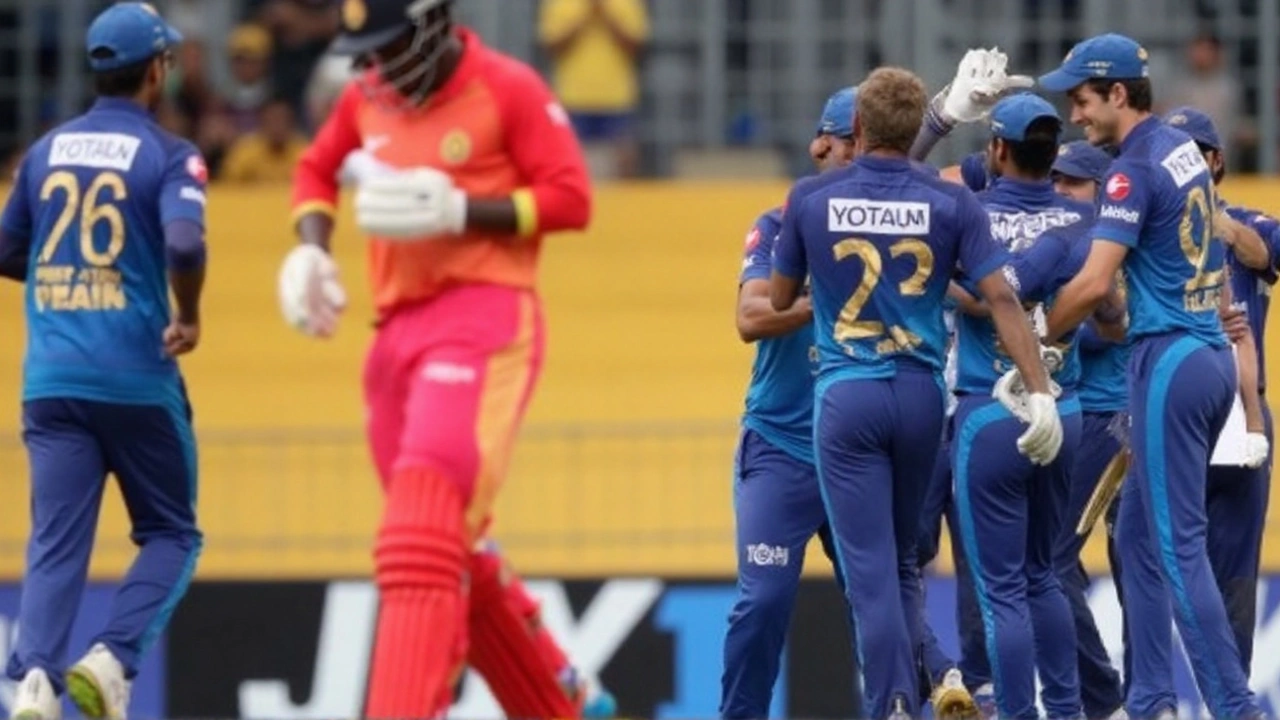Series on the line in Harare
Six wins in seven T20Is. That’s Sri Lanka’s record against Zimbabwe, and it’s the shadow hanging over this game. The visitors are 1-0 up heading into the Zimbabwe vs Sri Lanka 2nd T20I at Harare Sports Club on September 6 (5:00 PM IST), with a chance to seal another white-ball series on tour. Zimbabwe aren’t out of this by any stretch—they were competitive in the opener, got the ball to grip later, and put up enough runs to stay in the fight. But they need a cleaner powerplay and fewer free hits in the middle to level the series.
Conditions should be bright and hot—daytime start, around 29–30°C, a light breeze, and no rain in the forecast. That means a hard new ball, true bounce, and early value for strong hands and clean swings. After the shine goes, expect the pitch to slow up. Spinners will drag length back and make shot-making a little messy around overs 7–15. This bend in the surface is often where the game tilts in Harare.
We got a clear read in the opening T20I: 350+ runs, 13 wickets, and Zimbabwe hitting 20 fours. Stroke-makers can cash in as long as they earn the right—stay in for two overs, then press the throttle. The first twenty balls for each team will shape the game. Nail that period, and you control the pace later when the ball softens.
So what’s the toss call? Bat first still feels like the safer option here. An afternoon start cuts out the evening dew, so spinners should stay in the game second innings too. A par total sits in the 165–175 band, and anything above 185 begins to feel heavy if the ball grips. Sri Lanka have chased tight targets well on this tour, but Harare in the afternoon isn’t your typical chase-friendly venue once spinners squeeze the middle.
Zimbabwe’s plan is simple but hard to execute: protect early wickets, play risk-managed tempo until over 8, and let Sikandar Raza and Ryan Burl attack the seamers at the back end. Zimbabwe’s bottom half can hold a bat, but they’re not built to sprint if five down in the 12th. They need Raza facing at least 30 balls to shape a total. Brad Evans and the tall seamers—Richard Ngarava and Blessing Muzarabani—then have to hit deck hard lengths and force Sri Lanka’s hitters square of the wicket, where the bigger pockets are.
Sri Lanka’s blueprint travels well: Pathum Nissanka and Kusal Mendis set a fast baseline, Charith Asalanka steadies and accelerates, and the lower middle keeps a punchy tail with Dasun Shanaka and Kamindu Mendis. With the ball, Dushmantha Chameera and Nuwan Thushara attack the stumps up front and at the death, while Maheesh Theekshana and Dushan Hemantha own the long middle. That balance is why they’ve been edging the clutch moments all tour, even when games got scrappy.
There’s no big injury chatter from either camp, so changes—if any—will be tactical. Zimbabwe could be tempted to sneak an extra spinner into the XI if they feel short on middle-overs control, but their listed group hints they’ll trust Raza, Burl, and Tony Munyonga to share those overs around the main seamers. Sri Lanka, meanwhile, won’t want to fiddle with a winning structure unless they chase match-ups—Kamindu’s handy off-spin versus left-handers, or Asalanka leaning on Theekshana earlier if Zimbabwe start fast.
The series context matters. Sri Lanka have already banked the ODIs and have won tight white-ball matches all trip. That bleeds into decision-making under pressure—better field placements in the 18th, smarter end choices, clearer option-taking for seamers at the death. Zimbabwe, though, look close. They’ve landed body blows without stacking them. One crisp powerplay with the bat and a disciplined six-over spin block could flip the script.

Predicted XIs, key battles, and what could swing it
Zimbabwe predicted XI
- Brian Bennett
- Tadiwanashe Marumani (wk)
- Sean Williams
- Sikandar Raza (c)
- Ryan Burl
- Tony Munyonga
- Tashinga Musekiwa
- Brad Evans
- Tinotenda Maposa
- Richard Ngarava
- Blessing Muzarabani
Sri Lanka predicted XI
- Pathum Nissanka
- Kusal Mendis (wk)
- Kusal Perera
- Nuwanidu Fernando
- Charith Asalanka (c)
- Kamindu Mendis
- Dasun Shanaka
- Dushan Hemantha
- Dushmantha Chameera
- Maheesh Theekshana
- Nuwan Thushara
Key battles
- Maheesh Theekshana vs Zimbabwe’s left-handers: Theekshana against the newish ball is a handful, especially to batters looking to lap or sweep early. If he wins that mini battle, Zimbabwe’s tempo gets stuck in second gear.
- Dushmantha Chameera/Nuwan Thushara vs Brian Bennett and Tadiwanashe Marumani in the powerplay: Raw pace and slingy angles versus two shot-makers who like width. Win rate here decides whether Zimbabwe are 45/1 or 28/2 after four.
- Sikandar Raza vs Sri Lanka’s middle-overs spin: Raza’s match control with the bat and ball is Zimbabwe’s lever. If he neutralizes Theekshana/Hemantha and then targets pace at the back end, Zimbabwe are suddenly at 9.5 an over with wickets in hand.
- Richard Ngarava’s new ball vs Pathum Nissanka: Left-arm angles into the channel at the top of off can drag Nissanka across his stumps. If Ngarava pins him early, Sri Lanka lose their cleanest powerplay structure.
- Ryan Burl vs Dushan Hemantha: A battle of options—Burl’s sweep range versus Hemantha’s pace changes. One over here can be a 6 or a 16, and it matters.
Pitch and tactics
Harare Sports Club usually gives you full value if you hit the V in the powerplay—true bounce, skiddy pace. Once the ball softens, cutters bite, back-of-a-length holds a fraction, and singles become the glue. The smart batting move is to keep a boundary every eight to ten balls, not chase four-fours-in-an-over dreams that can blow up an innings.
The ground isn’t tiny. Square can feel big; straight is the safer scoring line. That nudges teams toward smart use of the crease, not just muscle. Batters who can improvise—scoop early against pace, then switch to hard sweeps versus spin—tend to shape innings here.
Bowling-wise, hard length into the pitch with a ring on the off side works late. Yorkers are gold if you nail them, but this surface rewards into-the-wicket pace-offs just as much. Zimbabwe’s trio—Muzarabani’s bounce, Ngarava’s angle, Evans’ cutters—can create a sticky lane from overs 16–19 if they protect straight boundaries.
Form threads
Sri Lanka’s white-ball tour has been a study in nerve: close margins, tidy fielding, and enough batting depth to survive collapses. They haven’t needed huge individual scores because they’ve found 25s and 30s at the right times. Charith Asalanka, with his calm hands and good strike rotation, is central to that template. Kusal Mendis’ timing up top also matters—if he clears the infield twice early, he forces captains to shift fields, opening singles for everyone else.
Zimbabwe’s energy is real. They’ve matched Sri Lanka’s intensity and kept games competitive through grit and match-ups. The gap has been decision-making under stress—an over too many from the wrong end, a missed single before a big shot, a fielding error at a bad time. That’s fixable. The talent is here, led by Raza’s game-reading, Sean Williams’ calm through spin, and Burl’s finishing.
What Zimbabwe must fix
- Powerplay strike rate without chaos: 42–48 in the first six with one wicket down is a win. That keeps Raza from walking into rescue jobs.
- Spin squeeze: One of Raza/Burl/Williams has to play the control role for three overs—no loose ends, no freebies.
- Death clarity: Identify the hitter bowlers. Attack pace on length, avoid Theekshana’s late push if he holds an over back.
What Sri Lanka will bank on
- Top-order stability: One of Nissanka or Mendis batting into the 12th keeps the chase or build steady.
- Spin discipline: Theekshana setting the agenda and Hemantha supporting means fewer panic balls.
- Death execution: Thushara’s sling at the toes and Chameera’s hard length into the hip line up well against Harare’s late grip.
Par score and game shape
Expect captains to eye 170 as the mark. If the first innings crosses 185, that probably needs two set batters or a late cameo that hits 20 off eight. Chasing that in afternoon heat with tacky overs from 10–15 isn’t fun. If the pitch looks even slower than in the opener, the par number slides to the 160 range, which makes each powerplay wicket even more valuable.
Players to watch
- Sikandar Raza: Bat, ball, leadership—he’s the hinge. If he faces 30 and bowls three tidy overs, Zimbabwe rise 15–20 runs above par.
- Charith Asalanka: He turns 128/3 into 176/5 with low-drama batting and field control. His captaincy calls around spin timing are huge.
- Maheesh Theekshana: Early control, mid-overs squeeze. The matchup card Sri Lanka will play whenever Zimbabwe line up a launch.
- Richard Ngarava: The left-arm new-ball test for Sri Lanka’s right-handers and a nasty customer at the death with pace-offs.
- Kusal Mendis: If the timing clicks early, fielders get dragged, and Sri Lanka’s innings breathes easy.
Weather and timing
Sunny skies, around 29.4°C at start time, and a light cross breeze. No dew factor expected with the afternoon start (5:00 PM IST), so spin should remain a player across both innings. That also pushes captains toward bat-first if conditions look anything like the opener.
Broadcast
Live on the FanCode app and website for viewers in India. First ball at 5:00 PM IST from Harare Sports Club.
The bottom line
Sri Lanka arrive with the stronger, deeper batting and a bowling unit that covers every phase. Zimbabwe have home smarts, Raza’s all-round control, and the kind of surface that lets spinners write the middle. If Zimbabwe tidy up the powerplay and find 12 boundary balls in the last six overs, we’re heading to a decider. If Theekshana and the seamers own the middle and death again, the visitors go home with another series in the bag.
